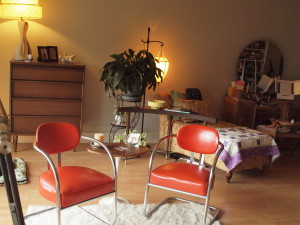 Most of my thinking, writing and working involves the bigger picture of our places – buildings, landscapes, communities. But what probably impacts us more every day are our interior spaces – the furniture, fabrics, finishes and things with which we surround ourselves. And I don’t know about you, but I rarely consider how safe I am in my house or my office. Until, that is, I heard the evaluation on fire retardants that one of my students in FIT’s graduate program of Sustainable Interior Environments presented as her thesis. Jessica Andrisano’s findings and questions will form the core of a panel on Fire Retardants being presented in New York city on Wednesday, March 5th at Teknion’s showroom on Avenue of the Americas.
Most of my thinking, writing and working involves the bigger picture of our places – buildings, landscapes, communities. But what probably impacts us more every day are our interior spaces – the furniture, fabrics, finishes and things with which we surround ourselves. And I don’t know about you, but I rarely consider how safe I am in my house or my office. Until, that is, I heard the evaluation on fire retardants that one of my students in FIT’s graduate program of Sustainable Interior Environments presented as her thesis. Jessica Andrisano’s findings and questions will form the core of a panel on Fire Retardants being presented in New York city on Wednesday, March 5th at Teknion’s showroom on Avenue of the Americas.
The Truth About Fire Retardants
Jessica is a practicing interior designer who works for HDR Architecture who found herself specifying furniture when she had no idea how safe it was. Since she was studying for her Master’s full-time while still working full-time, she realized she could conduct a thesis study that made a true impact on her business. A summary from Jessica is below:

Since I heard Jessica’s research, it makes me wonder how safe anything we live with is, like my Midcentury Modern Kem Weber-like chairs, for example.
“My thesis evolved from a multitude of questions I had about the use of fire retardants in commercial furniture…What exactly are the codes and how are chairs constructed to meet the code? If flame retardants are used in all commercial furnishings, which ones?
How do manufacturers ensure that a chair complies with fire standards?
As a part of my thesis, I conducted a survey with furniture manufacturers. The conclusions to my primary research were:
Most commercial upholstered furniture is constructed in a similar manner, with a wood or steel frame, support webbing, foam padding, and fabric.
Manufacturers send products to third party laboratories for fire testing but the three manufacturers that responded to my survey only tested their furniture to the most stringent test, CAL 133 (a burn test). They did not mention testing to TB 117 or TB 116 (fire behavior and compliance tests).
One of the manufacturers confirmed use of fire retardant materials in their foams but did not provide specific info about the chemicals used. The polyurethane foam association, however, reported that typical US fire retardant additives for foam are mixtures of brominated flame retardants and phosphate esters such as Firemaster 550 and 600, or chlorinated phosphate esters such as TDCP (a highly toxic fire retardant linked to cancer).
From both this study and secondary research sources, it is perceived that furniture manufacturers are meeting the TB 133 standard by wrapping foam with a barrier material. The EPA has reported that some barrier materials are natural fibers such as cotton with a chemical treatment, typically boric acid. Another option is a blend of synthetic materials, such as Kevlar, Nomex, polybenzimidazole, VISIL, Basofil and natural fibers. A third option is to utilize synthetics fibers with inherent flame resistance. Fire-retardant films, such as Neoprene, are also being utilized.
Unfortunately, the conclusions from my research are limited because I only received three responses to my questionnaire. It also seemed that with every response I received that I had another question. For instance, it seems standard practice to wrap foams in-order to meet TB 133; however the study did not reveal which materials are being used to encase the foam.
It also seems manufacturers are only testing to meet TB 133 meaning they are not testing chair components for compliance with TB 117. What I have gathered is that they are simply procuring foam and fabrics that meet 117 requirements.
One of the respondents said…“We purchase from a large distributor with little to no control over the ingredients included in the process. They provide to a massive industrial base, we are small buyer within their portfolio. Therefore, we do not know the specific FR but they are likely to be halogenated (Br or Cl). “
Because of the complicated supply chains involved in manufacturing, future research may be more viable if conducted first with raw material and/or component suppliers. After months of research with such a complex topic it seemed most pertinent for my thesis to provide a general overview of the current state of affairs with regards to fire retardants; compiling my secondary and primary research. I am very happy to report that it seems that some of my research may be null due to the changing regulations.”
Life Cycle Supply Chains

It’s mind boggling to think how many furnishings and fabrics are inside the buildings in NYC alone and leaves me pondering if we’re safe anywhere from fire or even the fire retardants!
Understanding life cycle supply chains, throughout everything we have on the planet, is one of the most challenging aspects of our new green world. No matter how hard we all try, we often seem to be in the same boat as the respondent above who said he has no way of understanding what ingredients they are actually purchasing from their distributor. Let’s hope that Jessica’s optimism about new regulations starts to permeate more and more of the architectural and interior design supply chain. Brava to Jessica for taking on such a timely and important topic!
If you’re in NYC on Wednesday March 5th and this topic intrigues you, please join our FIT and green building colleagues for “The Truth About Fire Retardants,” at 6:30PM at the Teknion Showroom on 641 Avenue of the Americas. It’s free and Teknion will provide refreshments. Sustainability experts and leading practitioners in the field will join Jessica on a panel.
And if you’d like to “subscribe” or follow my blog, True Green Cities, please sign up through the “Subscribe” button at the bottom left of this page. You’ll receive a daily recap when new blogs are posted. Or Sign up for the Feed.

